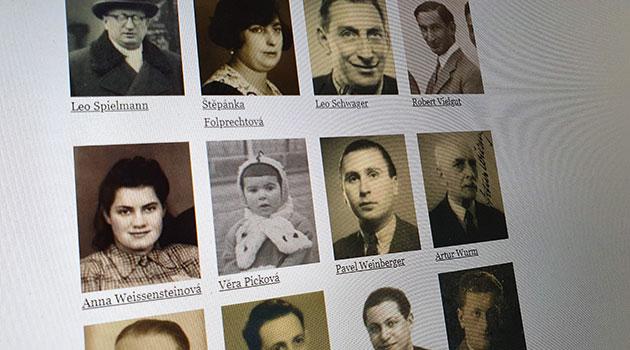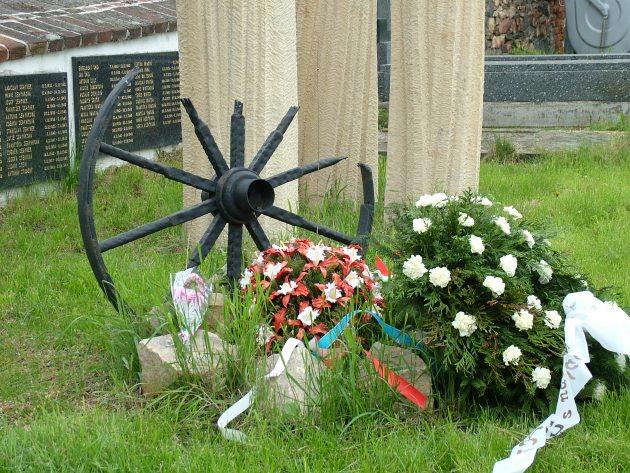Czech website on the Holocaust launches database of victims labeled "cikáni" by the Nazis and their accomplices

The database of Holocaust victims available online in Czech, English and German at holocaust.cz now has a new section containing data about more victims of racial persecution in the Protectorate of Bohemia and Moravia, those who were labeled “cikáni” during the Second World War. The Nazis’ racist persecution of those labeled this way affected most of the Roma and Sinti people during the Second World War who were living on the territory of what is today the Czech Republic.
Despite the gravity of that fact, the subject of the genocide of these people was not reflected upon by most of Czech society until 1989, for many reasons. Even though, under conditions of democracy, there is a development ongoing in the Czech Republic of the commemoration of this history, education about it, and research into it, even today these themes are not a natural component of mainstream awareness, as is documented by the decades it has taken for the memorials at Hodonín u Kunštátu and Lety u Písku to be created, as well as the periodic recurrence of the belittling or even the denial of the genocide of the Romani people here.
On 13 May 2020, the educational portal holocaust.cz launched a new database containing information about the victims of the Nazi genocide of those labeled “cikáni” on the territory of what is today the Czech Republic. Currently data is available there about the people who perished in the Protectorate’s “Cikánský camp” (the “Zigeunerlager” or “CT Lety“) at Lety u Písku, which was in operation from August 1942 to August 1943.
The Institute of the Terezín Initiative (ITI – Institut Terezínské iniciativy), since its establishment in 1993, has been systematically dedicated to the commemoration of the Holocaust and research about Holocaust victims, and since 2008 it has published a Database of Victims at holocaust.cz. Information was first published there about those victims who had been labeled “Jews” according to the Nuremberg Laws then in effect.
The Database of Victims draws from the data published in the Terezín Book of Memory (Terezínská pamětní kniha, vols. 1 and 2), which were published in 1995 by Melantrich and the Terezín Initiative and contain data about the Jewish victims of the Nazi deportations from Bohemia and Moravia that took place from 1941 to 1945. That information has been constantly augmented and expanded ever since, not just by new data, but also with archival documents and photographs thanks to which it is possible to restore not just these people’s faces, but also their life stories.
The Database contains brief information about all the prisoners in the ghetto at Terezín who were then deported from the Czech lands – prisoners from Austria, Denmark, Germany, the Netherlands and Slovakia – as well as those who arrived at Terezín during the final days of the war in the death marches (the so-called “evacuation transports”). Information is also available there about those who were deported from the Czech lands directly to Auschwitz, Łódź, Minsk and Ujazdów, or who were imprisoned in the concentration camp at Mauthausen.
Another difficult task the ITI staffers set themselves was to also commemorate other victims of the Nazis’ racist policy during the Second World War, namely, those who were labeled “cikáni” by the bureaucratic powers. ITI historians began to systematically dedicate themselves to that task four years ago.
The historians based that work on their experience with the database of Jewish victims and adapted their existing approaches to the specific needs of the new project. At the very beginning, archival research was undertaken in three archives holding basic collections on the subject of the persecution of the Roma and Sinti on Czech territory: the National Archive of the Czech Republic in Prague, the Moravian Provincial Archive in Brno, and the State Regional archive in Třeboň.
Research in archives abroad was also important, for example, in the Bundesarchiv in Berlin, Germany, or the archive of the Auschwitz-Birkenau Museum in Oświęcim, Poland. It was also necessary to visit other Czech archives such as the archives at Mikulov in South Moravia, Zámrsk in East Bohemia, the City of Brno, the City of Prague, and others.
With the growing amount of accumulated data and documentation it then became necessary to set other goals to be achieved within the timeframe established and to focus the research in that direction. Given that the digitalization of the entire archival collection about “CT Lety” in the Třeboň archive had been part of the research from the beginning, data about the prisoners from the camp at Lety u Písku was chosen to be publicized first.
Lists of the prisoners’ names were found and transcribed from the documents in that collection, and the data there were compared with the published lists of prisoners that had been previously produced by the historian Ctibor Nečas. From the larger set of those imprisoned at some point at the Lety camp, ITI has chosen to publish data just about those who perished there.
The Database of Victims has two sections, a public-facing section and one that is not accessible by the public. The public section is accessible at holocaust.cz and contains data just about persons who were murdered or who died as a consequence of their imprisonment.
In order to protect personal information, it is not possible to publish data about survivors or about those whose fates have not yet been traced. Even though their names have been published in book form – as have, for example, the prisoners of the ghetto at Terezín in the Terezín Books of Memory (Terezínská pamětní kniha, vols. 1 and 2) – that data remains in the part of the database that is accessible just to curators.
This does not mean, however, that these data cannot be made accessible. It is possible to access data on the basis of a research request.
This same approach was chosen when it came to expanding the database to include the Lety prisoners. In the public section of the database, identification information is published about prisoners who died in the “Cikánský camp” at Lety between August 1942 and August 1943, the time it was in operation.
A database user will find a name and surname (either a birth surname or a subsequent surname), a date and place of birth, the length of imprisonment, and a date and place of death. The rest of the information found (the larger part) is in the part of the database that is not publicly accessible.
On the basis of consultations with experts and representatives of the family members of those imprisoned at Lety, the project team decided all the data and information found and processed would be stored just in the part of the database that is not publicly accesible. Documentation and information has been included in the database for each victim so that, from among the innumerable persons murdered there, it is possible to present these children, men and women as individuals.
Database users also are able to access archival documents and photographs that give a sense of each victim as an individual figure who lived until his or her life was forcibly interrupted by the events associated with this racial persecution during the Second World War. These documents and photographs are predominantly from archives in Bohemia and document just one dimension of these individuals’ lives, namely, the record left in official documents.
The daily, private lives of these victims are documented by photographs contributed to the database by private donors, predominantly family members of the victims. To restore a face and a life story to each victim, however, is a labor that will never end.
Documents have not always been conserved, it is not always possible to identify the people in these old photographs, and those who might be able to do so are not always still among the living. One such victim of the Nazi persecution of the “cikáni” during the Second World War was Tekla Šimandlová (born 1902), who was imprisoned at Lety u Písku, at Hodonín u Kunštátu, and at Auschwitz-Birkenau, where she perished.
In the summer of 1942, when the forced concentration of persons labelled “cikáni” and “cikánský half-breeds” began to be implemented on the territory of the Protectorate, Tekla Šimandlová lived with her children in Plzeň and was a manual laborer. On 3 August 1942, all of them were imprisoned in the newly-opened “Cikánský camp” at Lety u Písku.
Her daughter Marie was transported from the camp to the hospital in Písek with a diagnosis of typhoid fever, while Tekla, her daughter Anna, and her son Josef were transported to the camp at Hodonín u Kunštátu after the Lety camp was closed. Tekla, Anna and Josef were then deported from Hodonín u Kunštátu to Auschwitz-Birkenau, where she died on 7 December 1943; the fates of her children have not yet been clarified.
The ITI database should function as an easily accessible information source and a resource for developing the discussion of these issues today. Expert commentaries are, therefore, also part of the database, explaining various concepts and subjects and contextualizing the published data and materials.
These commentaries will be followed by academic articles and possibly other outputs. In future the database should be expanded to include more information, above all about the victims of the “Cikánský camps” at Hodonín u Kunštátu and Auschwitz-Birkenau.
First published in Czech in the magazine Romano voďi.
